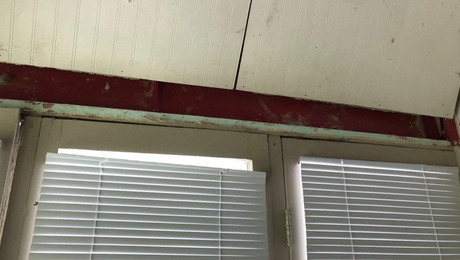Understanding Energy-Efficient Windows
How today's high-tech windows work and what to look for when making your next purchase
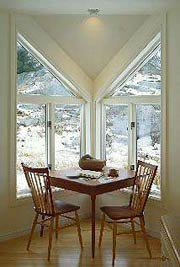
A respected builder I know told me how he learned the true value of energy-efficient windows. In the course of his business, he installed a builder’s line of windows from a well-known manufacturer in every house he built. He felt good about his choice; he purchased the windows from a manufacturer with a reputation for quality, but they cost 10% less than the same manufacturer’s standard line of low-E, argon-filled windows, saving him about $600 per house. He even put them in his own new home. The first winter he lived there, though, he noticed that the windows seemed cold. Only then did he compare the U-values with the same manufacturer’s standard windows. He did some math and concluded that his windows were costing him about $150 a year. By his estimation, the low-E windows would have paid for themselves in four years and made his home more comfortable for their entire life span.
My friend based his conclusions on widely accepted averages, and although certainly not exact, they were probably not far off the mark. Experiences such as his are common, yet they are easily avoidable with a basic understanding of how energy-efficient windows work. When you choose new windows, appearance is often the first consideration. Initial cost is the next issue: Which window within the favored style costs the least? But liking a window’s appearance is a fuzzy proposition, and cost really depends on durability and on the energy dollars pumped through the windows each year (see Annual heating costs). I am convinced that if we could see energy loss as we see color and shape, energy performance would top the list of window considerations.
Windows are thermal holes. An average home may lose 30% of its heat or air-conditioning energy through its windows. Energy-efficient windows save money each and every month. There are even some cases where new windows can be net energy gainers. The payback period for selecting energy-efficient units ranges from two years to ten years. In new construction, their higher initial cost can be offset because you’ll probably need a smaller, less expensive heating and cooling system. And more-durable windows may cost less in the long haul because of lowered maintenance and replacement costs. Plus, you’ll be more comfortable the whole while you live with them.
Heating and cooling costs
Window choice has a real impact on heating and cooling costs. This chart is based on a computer model of heating costs for a 1,540-sq. ft. house with R-30 ceiling insulation and R-19 in the walls and floor. The window area is equal to 15% of the floor area.
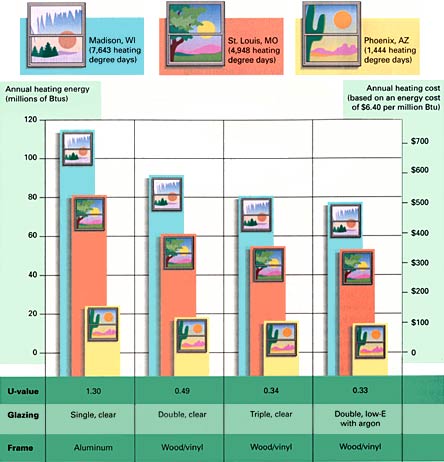
Keeping heat in (or out)
Windows lose and gain heat by conduction, convection, radiation and air leakage. This heat transfer is expressed with U-values, or U-factors. U-values are the mathematical inverse of R-values. So an R-value of 2 equals a U-value of 1/2, or 0.5. Unlike R-values, lower U-value indicates higher insulating value.
Conduction is the movement of heat through a solid material. Touch a hot skillet, and you feel heat conducted from the stove through the pan. Heat flows through a window much the same way. With a less conductive material, you impede heat flow. Multiple-glazed windows trap low-conductance gas such as argon between panes of glass. Thermally resistant edge spacers and window frames reduce conduction, too.
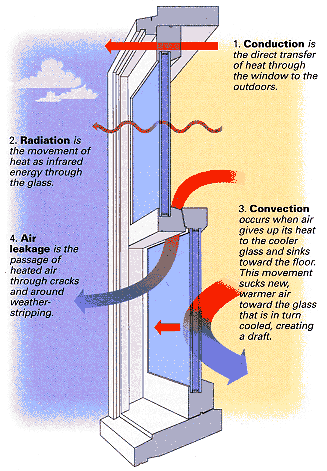
Convection is another way heat moves through windows. In a cold climate, heated indoor air rubs against the interior surface of window glass. The air cools, becomes more dense and drops toward the floor. As the stream of air drops, warm air rushes in to take its place at the glass surface. The cycle, a convective loop, is self-perpetuating. You recognize this movement as a cold draft and turn up the heat. Unfortunately, each 1°F increase in thermostat setting increases energy use 2%. Multiple panes of glass separated by low-conductance gas fillings and warm edge spacers, combined with thermally resistant frames, raise inboard glass temperatures, slow convection and improve comfort.
Radiant transfer is the movement of heat as long-wave heat energy from a warmer body to a cooler body. Radiant transfer is the warm feeling on your face when you stand near a woodstove. Conversely, your face feels cool when it radiates its heat to a cold sheet of window glass. But radiant-heat loss is more than a perception. Clear glass absorbs heat and reradiates it outdoors. Radiant-heat loss through windows can be greatly reduced by placing low-E coatings on glass that reflect specific wavelengths of energy. In the same way, low-E coatings keep the summer heat out.
Air leakage siphons about half of an average home’s heating and cooling energy to the outdoors. Air leakage through windows is responsible for much of this loss. Well-designed windows have durable weatherstripping and high-quality closing devices that effectively block air leakage. Hinged windows such as casements and awnings clamp more tightly against weatherstripping than do double-hung windows. But the difference is slight; well-made double hungs are acceptable. How well the individual pieces of the window unit are joined together also affects air leakage. Glass-to-frame, frame-to-frame and sash-to-frame connections must be tight. The technical specifications for windows list values for air leakage as cubic feet per minute per square foot of window. Look for windows with certified air-leakage rates of less than 0.30 cfm/ft2. Lowest values are best.

Letting in the right amount of sun
In a cold climate we welcome the sun’s heat and light most of the time. And once we capture the heat, we don’t want to give it up. In a warm climate, we don’t want the heat, but we do want the light. Advances in window technology let us have it both ways.
Less than half of the sun’s energy is visible. Longer wavelengths–beyond the red part of the visible spectrum–are infrared, which is felt as heat. Shorter wavelengths, beyond purple, are ultraviolet (UV). When the sun’s energy strikes a window, visible light, heat and UV are either reflected, absorbed or transmitted into the building.
Enter low-E glass coatings, transparent metallic oxides that reflect up to 90% of long-wave heat energy, while passing shorter wave, visible light. In hot climates, they reflect the sun’s long-wave heat energy while admitting visible light, thereby keeping the house cooler in the summer. And in cold climates, they reflect long-wave radiant heat back into the house, again while admitting visible light. This shorter wavelength visible light is absorbed by floors, walls and furniture. It reradiates from them as long-wave heat energy that the reflective, low-E coating keeps inside. Low-E coatings work best in heating climates when applied to the internal, or interpane, surface of the interior pane. Conversely, in cooling climates, low-E coatings work best applied to the interpane surface of the exterior pane.
Low-E coatings improve the insulating value of a window roughly as much as adding an additional pane of glass does. And combining low-E coatings with low-conductance gas fillings, such as argon or krypton, boosts energy efficiency by nearly 100% over clear glass. Argon and krypton are safe, inert gases, and they will leak from the window over time. Studies suggest a 10% loss over the course of 20 years, but that will reduce the U-value of the unit by only a few percent. The added cost for low-E coatings and low-conductance gas fillings is only about 5% of the window’s overall cost. It’s a no-brainer.

Taking in the view
Windows with high visible transmittance (VT) are easy to see through and admit natural daylight. Besides giving you a nice view, high-VT windows can save energy because you need less artificial light. Some tints and coatings that block heat also reduce visible transmission, so be careful. Manufacturers list the VTs of windows as comparisons with the amount of visible light that would pass through an open hole in the wall the same size as the window. VT is sometimes expressed as a “whole-window” value including the effect of the frame. What is important is the ability to see through the glass, not the frame, so be sure you get the VT of the glass, not of the entire unit.
The VT in residential windows extends from a shady 15% for some tinted glass up to 90% for clear glass. To most people, glass with VT values above 60% looks clear. Any value below 50% begins to look dark and/or reflective. Dariush Arasteh, staff scientist at Lawrence Berkeley Laboratory, warns, “People have very different perceptions of what is clear and what has a tint of color, especially when they look through glass at an angle.” Look at a sample of glass outdoors and judge for yourself before you decide to order the window.
It’s warm in the sun
Manufacturers have long used shading coefficient (SC) to describe how much solar heat their windows transmit. A totally opaque unit scores 0, and a single pane of clear glass scores 1 on this comparative scale. A clear double-pane window scores 0.84 because it allows 84% as much heat to pass as a single pane of glass.
Solar-heat-gain coefficient (SHGC) is the new, more accurate tool that is replacing SC to describe solar-heat gain. SHGC is the fraction of available solar heat that successfully passes through a window. It, too, uses a scale of 0, for none, to 1 for 100% of available light. The key difference is that SHGC is based on a percentage of available solar heat rather than on a percentage of what comes through a single pane of glass. It considers various sun angles and the shading effect of the window frame.
Glass coatings are formulated to select specific wavelengths of energy. It is possible to have a glass coating that blocks long-wave heat energy (low SHGC) while allowing generous amounts of visible light (high VT) to enter a home. This formulation is ideal in warm climates. A low SHGC can reduce air-conditioning bills more than if you increased the insulative value of your window with an additional pane of glass. I recommend a SHGC under 0.40 for hot climates. In cold climates you want both high VT and high SHGC. I recommend an SHGC of 0.55 and above in the North. In swing climates such as Washington, D.C., choosing a SHGC between 0.40 and 0.55 is reasonable because there is a trade-off between cooling and heating loads. For people in swing climates, Arasteh suggests, “Think about your specific comfort needs when specifying SHGC. If you like wearing sweaters and hate being overheated in the summer, then a low SHGC may be the choice for you.” Choose the blend of glass coatings that works best in your climate and exposure.
Preventing UV-damage
Windows that block UV-radiation reduce fabric fading. Expect to find windows off the shelf that block more than 75% of the UV-energy. Contrary to conventional wisdom, some visible light fades fabric, too. Some manufacturers use the Krochmann Damage Function to rate a window’s ability to limit fabric-fading potential. It expresses the percentage of both UV and of that portion of the visible spectrum that passes through the window and causes fading. Lower numbers are better.
Window manufacturers sometimes boast R-8 (U-0.125) values. Be careful. This may be only the value at the center of the glass, which is always artificially higher than the whole-unit value. Look for whole-unit values of U-0.33 or better. Some manufacturers stretch low-E coated plastic film within the gas-filled airspace of double-glazed units to provide an effective third or fourth “pane.” The weight of these windows is comparable to double glazing, and the true overall window performance is boosted to levels of U-0.17 or better for some. These units are pricey, but they can be more energy efficient than walls in cold climates. The R-value is lower than a typical wall, but if triple-glazed units are designed with a high SHGC and are placed in a sunny wall, they can be net energy gainers.
Keeping warm around the edges
If you’ve lived in a cold climate, you’ve seen condensation and even frost on windows. When warm indoor air cools below its dewpoint, liquid water condenses on the glass. Condensation typically develops around the edges of window glass. No surprise. The edge is where most multiple-pane glazing is held apart by highly conductive aluminum spacers.
The coldest part of a multiple-glazed window is around its edges. It’s worse with true divided-lite windows; because each lite has edge spacers, the ratio of cold edge to warm center is much higher than with regular insulated windows. Moist conditions support mold growth, and hasten decay and paint failure. Condensation is the No. 1 reason for window-related callbacks. Warm edges reduce the chance of condensation forming.
The material the spacer is made from affects the rate that heat travels through a window’s edge. Many window makers now offer warm edge spacers as standard fare. Aluminum spacers are not acceptable. The best windows use less conductive materials such as thin stainless steel, plastic, foam and rubber. Warm edge spacers can improve the U-value of a window by 10% and boost the edge temperature by around 5°F, thereby reducing condensation.
Energy-efficient glazing
Energy-efficient glazing reduces winter condensation. When low glass temperatures cause inside air to reach its dew point, water condenses on the window. The chart indicates the points where indoor humidity and outdoor temperature combine to cause condensation on various types of glazing. This chart is based on center-of-the-glass temperatures, but the edges are always colder, and condensation usually begins there.
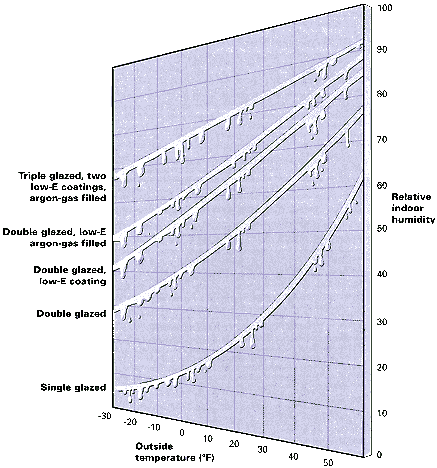
Good frames insulate
The most widely available window frames are wood (including vinyl-clad and aluminum-clad wood frames), with 46% of the market. Hollow vinyl frames hold 36% of the market, and aluminum runs a distant third, with a 17% market share. A trickle of alternative materials such as wood-resin composites, fiberglass, PVC foam and insulated vinyl makes up another 1% of windows sold. A window’s frame represents about 25% of its area. So it’s important that the frame material be thermally nonconductive. For the most part, wood and vinyl are the best performers, and they work equally well (see U-values for common frame materials). Aluminum frames are typically poor energy performers.
Connections where the frame joins together must be tightly sealed to keep out water and air. Weatherstripping needs to seal tightly after hundreds of window closings, rain wettings, sun dryings and winter freezings. Inexpensive, flimsy plastic, metal or brushlike materials don’t last. Compressible gaskets like those used to seal car doors are best. Closures must clinch windows tightly shut. Look carefully at these components, and ask your architect or builder about a particular brand’s track record. Pick longtime winners. Let others experiment with a new brand.
Wood is typically the most-expensive frame material. Maintenance is one of the biggest drawbacks to using solid-wood windows. Wood rots, shrinks and swells. Paint fails. Solid wood requires frequent, fussy maintenance. On the other hand, well-maintained wood looks good, is stable and can be recolored easily. Clad versions are the easiest to maintain. On the down side, if you get sick of the cladding color, too bad. When you choose either a solid or clad version, be sure that the manufacturer has treated its wood frames with water-repellent preservative to improve durability, paint retention and dimensional stability.
Frame materials also affect energy performance
There is a great difference in the insulative value of common frame materials. Here are some typical U-values for common frame materials.
| Frame material | U-value |
| Aluminum (no thermal break) | 1.9-2.2 |
| Aluminum (with thermal break) | 1.0 |
| Aluminum-clad wood/reinforced vinyl | 0.4-0.6 |
| Wood and vinyl | 0.3 – 0.5 |
| Insulated vinyl/insulated fiberglass | 0.2 – 0.3 |
Vinyl windows are built to move
Vinyl windows have been around for 35 years. Vinyl is energy efficient, durable, rotproof, insectproof and weather resistant. It’s made with chemicals that inhibit UV-degradation. Vinyl is colored throughout and requires no painting. The knock on vinyl is that it fades, can’t be painted, becomes brittle with age and is thermally unstable (especially dark colors). Temperature changes cause it to contract and expand more than wood, aluminum and even the glass it holds. Vinyl frames have the potential for causing increased air leakage over time because of this movement. But Richard Walker, technical director of the American Architectural Manufacturers Association (AAMA, 1827 Walden Office Square, Suite 104, Schaumberg, IL 60173; 847-303-5664 ), is quick to say, “Vinyl windows are built with this movement in mind, and failures have not been recorded to cause concern.” If you choose vinyl frames, specify light colors and heat-welded corners. Heat-welded corners hold up best over time.
The pigments that are used in paint are almost identical to those used in vinyl, but vinyl’s color goes all the way through. Walker says, “A little rubdown with Soft Scrub or one of the products on our (AAMA) list of recommended cleaners will bring vinyl back to its original brilliance.” I tried the Soft Scrub test and was impressed with how much brighter aged vinyl became. Not the original color, to be sure, but the scrubbing resulted in a marked improvement.
Fiberglass-frame windows are showing up in a few product lines. Fiberglass is extremely strong, and because it is made of glass fibers, the frames and the glass expand at the same rate. Fiberglass must be painted and is more expensive than vinyl. Owens Corning, Andersen and Marvin are three major manufacturers that produce fiberglass windows. Owens Corning is the only manufacturer that makes fiberglass windows with insulated frames. But before you get too excited, the whole-window U-value for a low-E argon-filled casement window carries the same 0.32 rating for both an uninsulated vinyl and an insulated fiberglass unit.
Aluminum-frame windows are durable, requiring little maintenance. However, they are energy siphons and shouldn’t be used where energy efficiency is a consideration.
The range of window options available today is staggering. But a working knowledge of the terms and these few guidelines should make choosing windows a little less intimidating (see Rules of thumb for window selection).
You might also want to get ahold of this book: Residential Windows: A Guide to New Technologies and Energy Performance by John Carmody and others, W. W. Norton & Co. Inc. (1996).
Rules of thumb for window selection
To get the best value from your windows, select units that match your climate. This chart suggests minimum values for the listed climates.
| Climate | Madison, WI (7,643 heating degree days) | St. Louis, MO (4,948 heating degree days) | Phoenix, AZ (1,444 heating degree days) |
| U-Value | Less than 0.33 | 0.33 | 0.33 |
| Visual transmission | 50% | Greater than 50% | Greater than 60% |
| Solar-heat-gain coefficient | 0.40 – 0.55 | Greater than 0.55 | Less than 0.40 |
| UV-protection | Greater than 75% | 75% | 75% |
| Edge spacers | Warm edge spacers | Warm edge spacers | Warm edge spacers |
| Frame | Nonconductive frames | Nonconductive frames | Nonconductive frames |
| Air leakage | Less than 0.30 cfm/ft2 | Less than 0.30 cfm/ft2 | Less than 0.30 cfm/ft2 |
Paul Fisette is director of the Building Materials Technology and Management Program at the University of Massachusetts in Amherst, MA (www.umass.edu/bmatwt). Chart information courtesy of W. W. Norton & Co. Inc., except where noted. Photo: Brian Vanden Brink; drawings: Dan Thornton.












